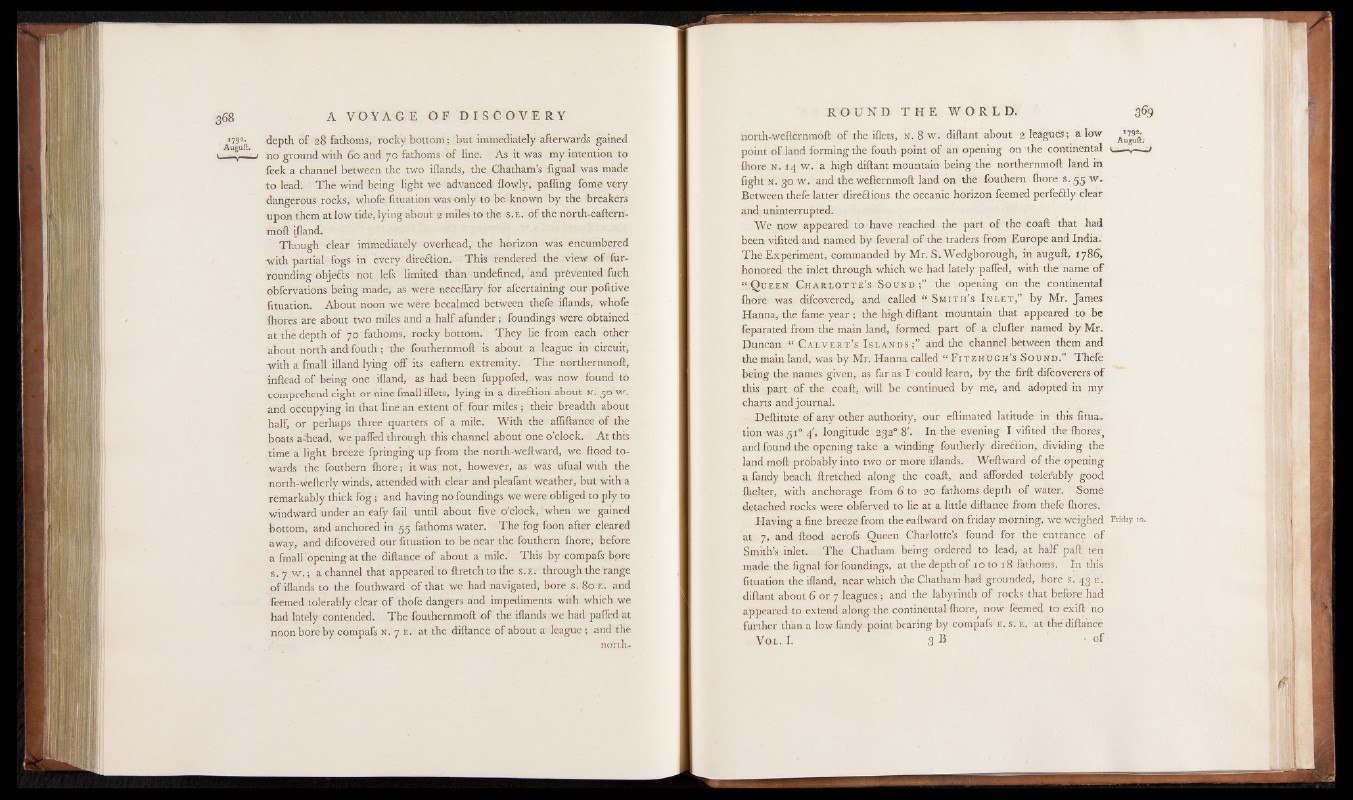
I792* depth of 28 fathoms, rocky bottom; but immediately afterwards gained
no ground with 60 and 70 fathoms of line. As it was my intention to
feek a channel between the two iflands, the Chatham’s fignal was made
to lead. The wind being light we advanced flowly, paffing fome very
dangerous rocks, whofe fituation was only to be known by the breakers
upon them at low tide, lying about 2 miles to the s.e. of the north-eaftern-
ffioft ifland.
Though clear immediately overhead, the horizon was encumbered
with partial fogs in every direction. This rendered the view of furrounding
objefitS not lefs limited than undefined, and prevented fuch
obfervations being made, as were neceflary for afcertaining our pofitive
fituation. About noon we were becalmed between thefe iflands, whofe
Ihores are about two miles and a half afunder; foundings were obtained
at the depth of 70 fathoms, rocky bottom. They lie from each other
about north and fouth; the fouthernmoft is about a league in circuit,
with a fmall ifland lying off its eaftern extremity. The northernmoft,
inftead of being one ifland, as had been fuppofed, was now found to
comprehend eight or nine fmall iflets, lying in a direction about N..50 w,
and occupying in that line an extent of four miles ; their breadth about
half, or perhaps three quarters o f a mile. With the afliftance of the
boats a-head, we palled through this channel about one o’clock. At this
time a light breeze fpringing up from the north-weftward, we flood towards
the fouthern fhore; it was not, however, as was ufual with the
north-wefterly winds, attended with clear and pleafant weather, but with a
remarkably thick fo g ; and having no foundings, we were obliged to ply to
windward under an eafy fail until about five o’clock, when we gamed
bottom, and anchored in 55 fathoms water. The fog foon after cleared
away, and difcovered our fituation to be near the fouthern fhore, before
a fmall opening at the diftance of about a mile. This by compafs bore
s .7 w .; a channel that appeared to ftretchtothe s.e . through the range
of iflands to the fouthward of that we had navigated, bore s. 80 K. and
Teemed tolerably clear o f thofe dangers and impediments with which we
had lately Contended. The fouthernmoft o f the iflands we had pafled at
noon bore by compafs n. 7 e. at the diftance of about a league ; and the
northnorth
wefternmoft of the iflets, n . 8 w . diftant about 2 leagues; a low A‘u^ ,
point of land forming the fouth point of an opening on the continental ,— .
fhore N. 14 w. a high diftant mountain being the northernmoft land in
fight N .g ow . and the wefternmoft land on the fouthern fhore s. 55 w.
Between thefe latter directions the oceanic horizon feemed perfectly clear
and uninterrupted.
We now appeared to have reached the part o f the eoaft that had
been vifited and named by feveral o f the traders from Europe and India.
The Experiment, commanded by Mr. S. Wedgborough, in auguft, 1786,
honored the inlet through which we had lately pafled, with the name of
« O u e e n C h a r l o t t e ’s S ound the opening on the continental
fhore was difcovered, and called “ Smith ’s I n l e t ,” by Mr. James
Hanna, the fame year ; the high diftant mountain that appeared to be
feparated from the main land, formed part of a clufter named by Mr.
Duncan “ C a l v e r t ’s I s l a n d s ;” and the channel between them and
the main land, was by Mr. Hanna called “ F i t &hugh’s S ound.” Thefe
being the names given, as far as I could learn, by the firft difcoverers of
this part o f the coaft, will be continued by me, and adopted in my
charts and journal.
Deftitute of any other authority, our eftimated latitude in this fituation
was 51° 4', longitude 232° 8'. In the evening I vifited the fhores,
and found the opening take a winding foutherly diredtion, dividing the
land moft probably into two or more iflands. Weftward of the opening
a fandy beach ftretched along the coaft, and afforded tolerably good
{belter, with anchorage from 6 to 20 fathoms depth of water. Some
detached rocks were obferved to lie at a little diftance from thefe fhores.
Having a fine breeze from the eaftward on friday morning, we weighed Friday 10.
at 7, and flood acrofs Queen Charlotte’s found for the entrance of
Smith’s inlet. The Chatham being ordered to lead, at half paft ten
made the fignal for foundings, at the depth o f 10 to 18 fathoms. In this
fituation the ifland, near which the Chatham had grounded, bore s. 43 e :
diftant about 6 or 7 leagues ; and the labyrinth of roeks that before had
appeared to extend along the continental fhore, now feemed to exift no
further than a low fandy point bearing by compafs f ! s. e_. at the diftance
V ol. I. 3 B - o f